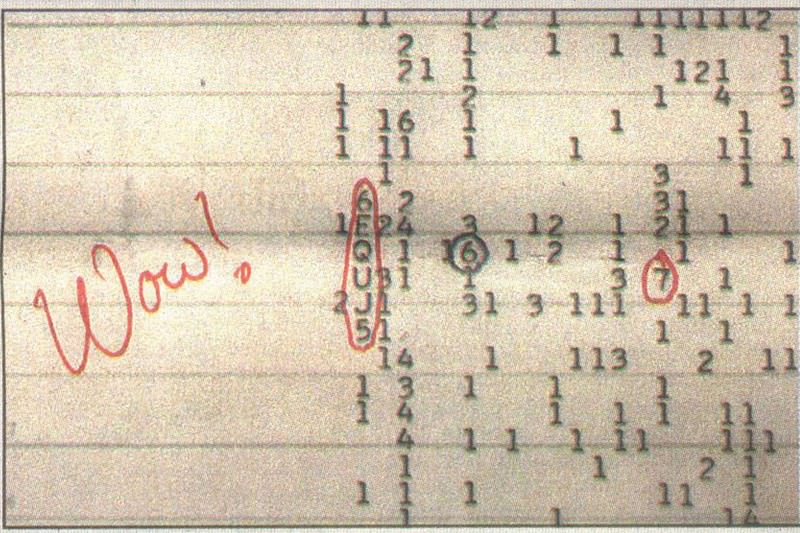
I have to say that if -IF- a natural cause for the Wow! Signal was found it might seem sad but, again, you have to dismiss the false data to get to the True data.
A lot of Signals from Space that the AOP Bureau under Franklyn Angus Davin-Wilson looked into did have natural causes because planetary noise, pulsars and so on were not known at the time. However, I have to agree that I am doubtful because of the hydrogen factor. I can't see this being correct but....
https://www.newscientist.com/article/dn28747-famous-wow-signal-might-have-been-from-comets-not-aliens/?utm_source=NSNS&utm_medium=SOC&utm_campaign=hoot&cmpid=SOC|NSNS|2016-GLOBAL-twitter
Famous Wow! signal might have been from comets, not aliens
On 15 August 1977, radio astronomers using the Big Ear radio telescope at Ohio State University picked up a powerful signal from space. Some believe it was our first interception of an alien broadcast. Now it seems something closer to home may have been the source: a pair of passing comets.The signal – known as the “Wow! signal” after a note scribbled by astronomer Jerry Ehman, who detected it – came through at 1420 megahertz, corresponding to a wavelength of 21 centimetres.
Searchers for extraterrestrial transmissions have long considered it an auspicious place to look, as it is one of the main frequencies at which atoms of hydrogen, the most common element in the universe, absorb and emit energy. What’s more, this frequency easily penetrates the atmosphere.
But in the 40 years since, we’ve never heard anything like it again. Analysis of the signal ruled out a satellite, and a reflected signal from the Earth’s surface is unlikely because regulations forbid transmission in that frequency range.
Antonio Paris, a professor of astronomy at St Petersburg College in Florida, thinks the signal might have come from one or more passing comets. He points the finger at two suspects, called 266P/Christensen and P/2008 Y2 (Gibbs). “I came across the idea when I was in my car driving and wondered if a planetary body, moving fast enough, could be the source,” he says.
Hydrogen clouds
Comets release a lot of hydrogen as they swing around the sun. This happens because ultraviolet light breaks up their frozen water, creating a cloud of the gas extending millions of kilometres out from the comet itself.If the comets were passing in front of the Big Ear in 1977, they would have generated an apparently short-lived signal, as the telescope (now dismantled) had a fixed field of view. Searching that same area – as subsequent radio telescopes did – wouldn’t show anything. Tracing the comets’ positions back in time, Paris says that the possible origin for the Wow! signal falls right between where they would have been.
Neither comet was known in 1977; they were both discovered in the last decade, which would mean nobody would have thought to search for them. The odds of any telescope catching them in the region of the Wow! signal by chance were vanishingly small.
To test his idea, Paris proposes looking at the same region of space when the comets are back. Comet 266P/Christensen will transit the region first, on 25 January 2017, then P/2008 Y2 (Gibbs), on 7 January 2018. An analysis of the hydrogen signal of the comets should reveal if he is correct.
Doubts signalled
Some researchers are sceptical, saying it isn’t clear the comets would release enough hydrogen to generate something like the Wow! signal. James Bauer of the Jet Propulsion Laboratory in Pasadena, California, agrees that the hydrogen from comets can extend quite far, but still thinks the signal won’t be strong enough. “If comets were radio-bright at 21 centimetres, I would be puzzled as to why they aren’t observed more often at those wavelengths,” he says.Paris says future observations will determine whether he is right. One crucial piece of evidence will be how fast the comets move across the sky. Too slow, and the Big Ear would have seen another signal 24 hours later as they rolled back into view, unlike the solo blast of the Wow! signal. “The hypothesis must be tested before it is ruled out,” he says. “Science 101.”
Journal reference: To appear in the Journal of the Washington Academy of Sciences, preprint
(Image credit: The Ohio State University Radio Observatory and the North American Astrophysical Observatory (NAAPO)
No comments:
Post a Comment